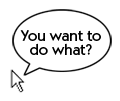
Here is an article that exposes usability in 10 easy to understand points through web design. Smashing Magazine also has older usability articles like 10 usability nightmares and 30 usability issues. They are all a must read.
One very important item, before I comment on their 10 points, is that users DON’T READ a website, users actually SCAN a website for information, then read. Something I scream to the wind as being true, and that actually explains a few of the points below.
Here are Smashing Magazine’s 10 principles of effective web design with my comments; do read their article for their original view and examples.
-
Don’t make users think – Simple, lay your website components out in an organized fashion and let users select what they want.
-
Don’t squander users’ patience – Users have all control, bother them with too much work, too many forms to fill (specially if you give them no incentive before they start) and they will leave.
-
Manage to focus user’s attention – Call attention to those parts of the website that are important, but don’t do over do it so you don’t undermine the other parts of the website. “Not all users are on the site for this month’s special.“
-
Strive for feature exposure – Guide your users on the site. Simple visual or text cues can make a huge difference.
-
Make use of effective writing – If users are accustomed to reading “Login” – “FAQs” and other names on most websites – why try to be fancy and change the text? Are you trying to hide the option so users don’t find it? Make ads with more information and less sales pitch. Users are interested in your product or service, they made the conscious effort to get to your site, they are reading your site right now – are you going to bore them with a sales pitch? This is the equivalent of a car’s salesman – I have yet to meet the first one that doesn’t turn me off as a client.
-
Strive for simplicity – Just don’t try to make your site the ultimate destination in the universe for all that is information. It is not and will never be, so keep both your design and content simple.
-
Don’t be afraid of white space – And this is where the business owner cries “But I paid for that space, I want more X-Y-Z in there.” – Then, after every single pixel of the page is filled with content and graphics and unicorns, the users cry because they have no white space to guide them & business owners cry because users leave their site as fast as they came in. Did I make my point that no white space = sadness?
-
Communicate effectively with a “visual language” – This relates to the fact that most users SCAN your site instead of reading it. You must organize, keep your content simple and communicate your message in a simple/balanced way. Read more about this in the original article.
-
Conventions are our friend – Again, don’t try to reinvent the Internet. Use tools, formats and design cues that are already tried and true. Designers and programmers have changed the way websites work during the history of the Internet. They have done the work for you; don’t try to go against what already works.
-
TETO – Test early, test often - You must test the design of your site early, before it goes into production and while it is in production. Sounds simple, and yet many people forget to do so.